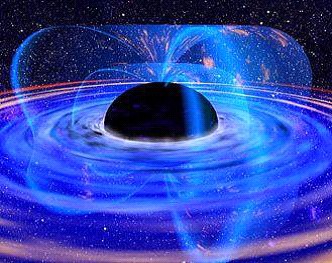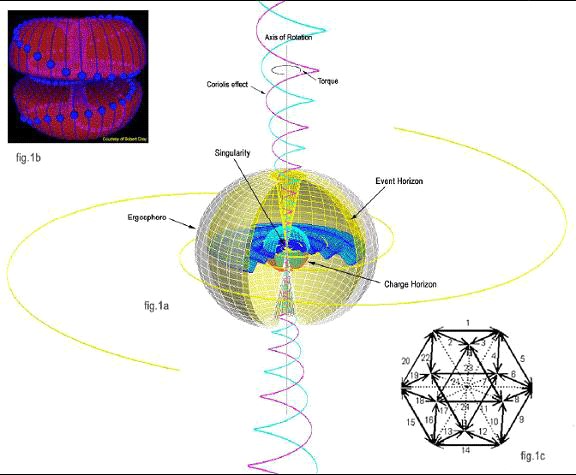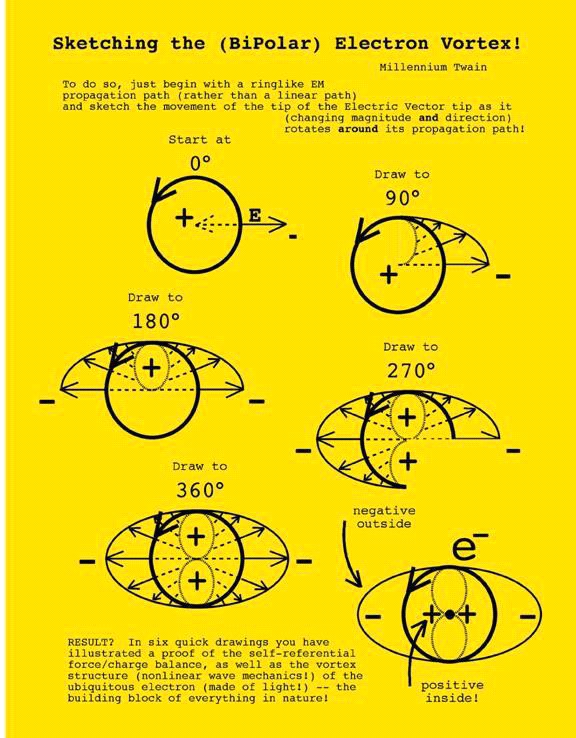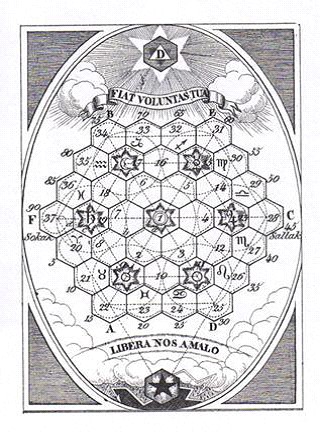
This image of the official N.A.S.A site depicts a black-hole, and as you can see the centre is not a disc but shaped like a globe. They speak of a singularity, a single point from where light does not escape but at the same time you see a field or fields around it coming from or going to this centre, like a magnetic field and there is a disc. Now it is said that everything is pulled into the black-hole, yet this disc has been there for millions of years.
Our galaxy is said to have a black-hole at its centre. A black-hole is at the same time a white hole, both creator and destroyer.
A single point could be seen as one dimension, the field as two dimensions and the whole as 3 dimensions. While this is a simplified representation it is also similar to that of matter itself. 2D like a sheet of paper can be rolled up. But 3D can roll up on itself too. Any of you who are more familiar with the star of Bethlehem and the thorus will recognize it in this representation of a black-hole.
Electrical and magnetic forces are part of the structure And the structure represents the natural flow of the electrical field. You will be able to see how energy is expressing itself mathematically. This math has no anomalies and shows the dimensional shape and function of the universe as being a thorus-shaped black hole. This is the template for the universe and it is all within our base ten decimal system!
It is a place where Numbers are real and alive, not merely symbols for quantity. You will discover that the relationships between numbers are not random or man-made but that numbers are actually elementary particles of which everything is composed. This lost knowledge was well known to our ancients and is now being uncovered for us today. Gradually you will come to see numbers in a simple yet profoundly perfect three-dimensional matrix grid pattern that forms the shape of a thorus. The number grid reveals the calibration and timing for an engine that can solve mankind’s energy needs, but much more, it is the blueprint of existence.
The following will show you that scientists are looking into this direction. Research is being done by scientist all over the world,’GUT’ the grand unification theory, is every scientists dream to solve, and the list of theories with some of the big names in science is long. But none of them have a complete theory, let alone a math that is so beautiful and perfect. All this as in large and small and much more, conscious, karma, cycles and purpose are all right in front of them, it was incorporated in the old temples, the pyramids and ancient scriptures, the Bhagavad-Gita, the Veda’s, the Koran, the Bible etc. All are based on this same wisdom.
This is what Albert Einstein said:
“During the last century, and part of the one before, it was widely held that there was an irreconcilable conflict between knowledge and belief. The opinion prevailed among advanced minds that it was time that belief should be replaced increasingly by knowledge; belief that did not itself rest on knowledge was superstition, and as such had to be opposed. According to this conception, the sole function of education was to open the way to thinking and knowing, and the school, as the outstanding organ for the people’s education, must serve that end exclusively. One will probably find but rarely, if at all, the rationalistic standpoint expressed in such crass form; for any sensible man would see at once how one-sided is such a statement of the position. But it is just as well to state a thesis starkly and nakedly, if one wants to clear up one’s mind as to its nature. It is true that convictions can best be supported with experience and clear thinking. On this point one must agree unreservedly with the extreme rationalist. The weak point of his conception is, however, this, that those convictions which are necessary and determinant for our conduct and judgments cannot be found solely along this solid scientific way. For the scientific method can teach us nothing else beyond how facts are related to, and conditioned by, each other. The aspiration toward such objective knowledge belongs to the highest of which man is capable, and you will certainly not suspect me of wishing to belittle the achievements and the heroic efforts of man in this sphere. Yet it is equally clear that knowledge of what is does not open the door directly to what should be. One can have the clearest and most complete knowledge of what is, and yet not be able to deduct from that what should be the goal of our human aspirations. Objective knowledge provides us with powerful instruments for the achievements of certain ends, but the ultimate goal itself and the longing to reach it must come from another source. And it is hardly necessary to argue for the view that our existence and our activity acquire meaning only by the setting up of such a goal and of corresponding values. The knowledge of truth as such is wonderful, but it is so little capable of acting as a guide that it cannot prove even the justification and the value of the aspiration toward that very knowledge of truth. Here we face, therefore, the limits of the purely rational conception of our existence.”
As said the wisdom of old has it all. And Einstein, Nikola Tesla, Leonardo Da Vinci, Copernicus knew they were looking for the science of god, the only wisdom that is based on love and the only love that has its basis in wisdom and gives purpose to all.
The following link will be of interest for some. http://theresonanceproject.org/pdf/torque_paper.pdf
The text and pictures that follow can be found at: http://www.galacticguide.com/articles/6R102.html



The search began with Isaac Newton. He first proposed the idea that one great theory might exist that would link all the other known theories. This theory would provide one blanket statement that would describe everything in the entire universe, known and unknown. Other physicists, starting with Albert Einstein, began searching for this grand unified theory, which, through their love of acronyms, they affectionately called GUT. Some even started calling it a theory of everything, which led to the acronym TOE. They started with four basic forces: the gravitational force, which Newton had earlier found to explain gravity; the electromagnetic force, a linked theory of electricity and magnetism; the strong nuclear force, which holds the nucleus of the atom together; and the weak nuclear force, which is involved in the decay of atoms. In 1979, Sheldon Glashow, Steven Weinberg and Abdus Salam combined the theories of electromagnetic and weak interactions into the electroweak theory(Elementary Particles). This was a gigantic step toward a GUT because it showed how two of the four main forces could be linked together with theories.
Theories are not enough for physicists, though. They are looking for tangible particles to explain and give concrete proof for the theories. The probability of finding new particles is growing as elementary particle physicists are gaining the ability to smash atoms together at incredibly high speeds. This is done in particle accelerators and supercolliders, which are large devices built to accelerate individual particles to almost the speed of light. The particles are then placed in line with other particles. The two bits of matter collide and produce astounding results; they are either broken into component pieces or fused together to create bigger, more massive particles. Both outcomes can be studied to provide more insight into the realm of the infinitesimally small.
Plans for the world`s largest supercollider are now being developed by the Conseil Europeen pour la Recherche Nuclaire, known in America as CERN (Dawson). This would be the furthest step ever taken by scientists, and the supercollider would have the capabilities of accelerating particles to faster speeds. Protons are often the particles accelerated, because of their small mass and relative stability. They are smashed into antiprotons, the particles with characteristics exactly opposite those of the proton. The second choice of particle physicists is the electron, being almost massless and easy to accelerate, smashing it into its opposite particle, the positron.
All this accelerating and colliding was meant to prove the existence of some fundamental particle, something which was the building block of all matter and could not be divided. Several hundred new particles were found, most of which could only exist within the stability of the accelerator. Some physicists, like to ban the finding of this array of particles to unscientific studies. In describing supercolliders, Victor Weisskoph analogizes, “If you want to know what is inside two Swiss watches, you bang them together as hard as you can and see what comes out” (Fisher). However unscientific, this “banging” has proven fruitful to scientists. They have found that in all the new particles they created, there were only twelve basic particles, called “matter particles”, which form everything known to humankind. They have also found several messenger particles, which carry the forces between the matter particles, and physicists hypothesize about more elusive messenger particles, like the yet undiscovered graviton, thought to carry the force of gravity, which they cannot create as of now. The direct result of all these studies is that scientists have taken the data and proposed a Standard Model, a “collection of theories that are brilliantly successful at delineating all the known truly elemental particles and their interactions” (Fisher).
The Road To A Grand Unified Theory.
The Standard Model, General Relativity, And Quantum Mechanics.
The Standard Model proposes a set of theories that explains the forces and the interactions between particles. These theories are basically accepted by physicists as accurate in describing the known universe. For most, however, even though they accept the Standard Model, they feel there is more to be discovered. There are two main theories that are used to describe everything; general relativity, proposed by Einstein and describing gravity as a result of curvature of space-time, and quantum mechanics, which describes force in terms of little packages (Bartusiak).
Physicists are searching for a GUT to describe all the known and unknown with one unified equation.
Marcia Bartusiak likes making these two theories compatible to “bowling with tiddlywinks” or “jumpstarting a car with an eggbeater”. To create a bridge between these two theories, some physicists have developed new hypotheses. One such hypothesis is called string theory.
String Theory
String theory proposes that at the “Planck length,” ten to the power of -33 centimetres, smooth spacetime dissolves into tiny vibrating loops called strings (Odenwald). These strings comprise the entire universe and everything in it, including space-time itself. The strings are identical, but depending on how they vibrate, they form everything in the universe: quarks, electrons, neutrinos, and all other particles (Taubes, A Theory of Everything).
The only catch to this theory is that it requires the strings to vibrate in ten dimensions (Kaku). In our known world, there are four dimensions: three of space and one of time. Physicists are just beginning to learn how to work in the extra six dimensions essential to string theory. They call this six-dimensional space “phase space”, and roll the dimensions up into tiny objects called “Calabi-Yau compactifications” (Cole). With these six-dimensional compactifications, though, comes a multitude of four-dimensional solutions to the theory. The main goal of physicists now is to choose the correct one that corresponds to our universe.
String theory holds much potential for physicists, but it is complicated and confusing, and thus has driven many scientists out of the field. In a new variant on string theory, black holes and strings are shown to be fundamentally alike, evolving into one another during a crucial point in the theorems called a “phase change” (Taubes, How Black Holes). These phase changes also link the Calabi-Yau compactifications, previously thought to be distinct entities. So-called dark matter, or “sparticles” (short for super particles) also helps string theory (Kaku). Sparticles serve to reduce the number of four-dimensional possibilities to string theory and make it considerably easier for physicists to find the real-world equivalent to the hypothesis (Peterson, Strings and Webs).
Michio Kaku insists that ten dimensions are necessary for string theory, because no fewer than ten dimensions can account for both general relativity and quantum mechanics, but Stan Odenwald maintains that it is possible to build working GUTs within four-dimensional space-time.
Supersymmetry
A separate theory, but still along these lines, is called supersymmetry. Supersymmetry maintains that there is a constant underlying symmetry between everything in the universe, that everything is alike underneath its appearance to humankind. Like string theory, supersymmetry includes more than the normal four dimensions that have been accepted by scientists. It is known to physicists that symmetry helps unify theories, and more dimensions means more symmetry, so there is a greater chance with supersymmetry that the forces can be linked together (Cole).
Superstring Theory
Neither of these theories, string theory or supersymmetry, can by themselves form a GUT, though, but physicists have made some progress linking the two to form a completely unified GUT. These theories linked together is called superstring theory. According to David H. Freedman, string theory is a “natural foundation” for superstrings, which are strings having the properties of supersymmetry. They are the same underneath, but depending on the frequency at which the superstrings vibrate, they can form particles or even forces. The symmetries of the particles can be glimpsed in proton collisions in particle accelerators. The collider at Fermi National Accelerator Laboratory in Illinois has produced, by means of a proton-antiproton collision, results that fit the assumptions of supersymmetry (Peterson, Hint of Supersymmetry). Supersymmetry looks to be the most promising road to a GUT.
Physics And Religion
Despite the lure of a true GUT, many people oppose the principle behind such a theory. Fundamentalists in particular are against it, saying that a GUT will undermine faith and religious beliefs. They have traditionally been opposed to anything that even slightly deviates from the Bible, believing instead in its literal interpretation, including the story of creation. They do not accept the big bang theory or the theory of evolution. However, some physicists say that religion and science are compatible. John Polkinghorne states that many people presume science is atheistic, but in fact, science asks the question “how”, and leaves the following question, “why”, up to the individual. Fundamentalists also believe that if a GUT is found, humanity might find no reason at all why they exist, and will lose all conscience. Steven Weinburg counters: “… if the laws of nature cannot give us a sense of conscience, neither can they take it away”. He continues to say that some religious beliefs are inappropriate in this age of science and technology, and science’s greatest service to humanity might be to take away those “childish” beliefs and help humanity “grow up”. The apex of the debate, however, is reached by Polkinghorne and George Greenstein, who say that our universe could not exist without the careful balance of the forces. If the forces were not exactly the strength they are, human life could never have evolved. Everything in the creation of the universe, Polkinghorne says, is so “finely tuned” that those who choose to believe in a creator have plenty of room alongside scientific theory to see threads of intelligence, or God, behind the seeming chaos of the creation of the universe. Science and religion can not only co-exist, they can thrive off each other.
Conclusion
Science has come a long way since the time that Isaac Newton first proposed the notion of a grand unified theory. Supercolliders and other particle accelerators have shown elementary particle physicists a whole new world of particles, and they have been able to show that only twelve of these make up everything in the known universe. They have found many particles also that do not exist under normal conditions, but that pop in and out of the vacuum of space to carry the basic forces. Physicists have been able to create theories like the string theory and super symmetry to explain these events, and have unified the two to create superstring theory. Science has taken a lot of flak for its search for a GUT, but many physicists argue that science and religion are completely compatible. The search for a grand unified theory is indeed a valuable one, and should be continued in order to further the understanding of all humankind.
A growing number of people are thinking about the meaning of life, and if you are to gain genuine peace of mind, you need to find answers, these are the most commonly asked questions, where did we come from, what is the purpose of life and what does the future hold? These are the typical questions mankind asks. So when the answers bring peace of mind then you are likely to find the answers when your mind is at peace, but this sounds like a contradiction. You might understand it when I say that the first bit “answers that will bring peace to mind” is reaching half way and the rest is given.
Scientist say that religion is based on believe, never wonder what these theories are? True, scientist try to prove their believe/theory, but so do those religious believers, they try to prove that their way is the right way, whether you take the Muslim faith or the Christian, they all read the same Koran and the same Bible yet interpret them differently not just between Muslims and Christians but between themselves. Some say that it has to be taken literally, but then while reading words like ‘heaven’ you find there are many different interpretations of what heaven is, you connect your own gained knowledge to these words and so read them accordingly. Who dares to say he is one with the writer or with Him who dictated them? The stories describe something by using what can be known so you are able to have an idea of the unknown, many take this idea as the truth. But the outer story and the laws given are a little like looking in the right direction but it does not mean you see what it is pointing at. Read the article about dreams again, where this higher knowing is dressed in material expression, is given a body. And the holy text clearly explains this. It is called parables (New Latin, from Greek parabol, comparison}
When you look at a dream, past experiences and present do you see the bigger picture? Or are you the clothing of…. To be in the eternal now, to be in it but not of it, to look outside the balloon detached from the lower illusionary I.
None of these theories are complete, scientists have to theorize new particles to make ends meet, but the Thorus and the star of Bethlehem as shown in the articles has everything.
08-02-2008
Moshiya van den Broek
